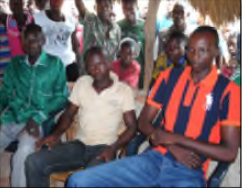
The PRADD II project returned to the Central African Republic in January 2016 thanks to support from USAID Bureau for Democracy, Conflict and Humanitarian Assistance (DCHA) intended to contribute to the return of peace and stability in diamond mining communities– the foundation of the war-torn national economy and the source of employment for thousands of diamond miners. During terrible civil strife from 2012-2014, rebel forces took over many diamond mining sites and used proceeds from illegal diamond export to finance purchases of arms and ammunition. For many years, no one visited diamond mining areas to assess the impact of the war, but with the return of the PRADD II project, the project carried out a month long diagnostic of how the diamond economy has evolved over the years and identified ways to return diamond mining areas to the peace and security once known.
Let’s listen to the tales of these key actors– people who suffered greatly, yet in some cases, perversely gained from the effects of war, but who are all looking forward to returning to the legitimate export of diamonds under the Kimberley Process Certification Scheme. These vignettes recounted to the PRADD II research team provide a glimpse into the complexities of bringing the country back to greater peace and security. Diamond for peace is the project mantra:
“My name is Ali Babolo. I’ve been working in diamond section for the past twenty years. I’m a Muslim diamond mining collector living as a refugee at the Catholic Church compound with my family. I so much want to return home, but my wish as well is to meet the new government officials after these recent elections to explain to them our suffering. I’d like to tell them this. There is not enough security in the diamond mining areas to guarantee my welfare. I’ve lived for two years here at the Catholic Church next to my Muslim brothers. I’ve lost a lot of equipment during this crisis — water pumps, bulldozers, my home in Yawa, and all my personal effects. Peace and security must return to diamond mining areas. But, I want to say this. There are no longer good relations between diamond collectors and the diamond houses like in the past (licensed diamond exporters). Well before the recent crisis, the diamond houses directly financed mining. Before, more than 800 collectors were financed by the diamond houses. Today, the number is much less as many are bankrupt and in debt.
Diamond mining activities have dropped off so much since the military and political crisis affecting the entire southwest. Circuits of fraud channel diamonds to Cameroon and Congo. The government needs to tighten things up because right now diamond mining and exports are opened up to anyone. There is too much smuggling and corruption in the mining area of Carnot. It’s up to the State and its partners to reinforce social cohesion and the legitimate relations between diamond diggers, us the diamond collectors, and the diamond export houses.”
For a different perspective, let’s listen to the stories of young diamond collectors, often the non-Muslim faith. These young people filled the gap left by Muslim diamond traders forced to flee during the war to safe havens, either in church yards or displaced peoples settlement camps in Cameroon:
“We are young diamond collectors between 27 to 36 years of age. We each have several wives and between 2-8 children to take care of. We buy and sell diamonds, but we also invest in stores selling motorcycles and car parts, build modern houses, and own motorcycle taxi services. We finance directly teams of diamond miners. We bought the new diamond collector license for 680,000 CFA (about $1,100).
We started our professional lives as simple owners of diamond mining claims and we hired workers. We benefited from the financial support of Muslim collectors and we learned much from the financial support of Muslim collectors and we learned much from them on how to organize diamond digging and buying and selling diamonds. We have attained our current status around 2015 after the war. Today, we carry out diamond trading once occupied by Muslim collectors. We are proud of our successes. We hope that the Central African Republican will return to peace and security because our livelihoods depend on this. We would like assistance from government to learn more about how to manage our finances. We would look forward to organizing ourselves better as diamond collectors.”
The PRADD II team in the Central African Republic builds strong trust with actors throughout the diamond mining sector. Through the recent one month long field diagnostic, the PRADD team met many people like those interviewed for this story. Passionate and insightful suggestions are often spelled out about how government, civil society and donor organization can contribute to rebuilding the synergistic relations that long existed in the diamond economy categories. But, times have changed. Dynamic youth have now filled the space left by the elder Muslim diamond traders. Returning the past may not work in a society fractured by the effects of the war.

